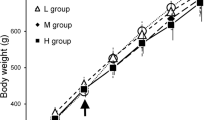Abstract
Phosgene is a highly reactive oxidant gas used in the chemical industry. Phosgene can cause life-threatening pulmonary edema by reacting with peripheral lung compartment tissue components. Clinical evidence of edema is not usually apparent until well after the initial exposure. This study was designed to investigate early signs of acute lung injury in rodents within 45–60 min after the start of exposure. Male mice, rats, or guinea pigs were exposed to 87 mg/m3 (22 ppm) phosgene or filtered room air for 20 min followed by room air washout for 5 min. This concentration-time exposure causes a doubling of lung wet weight within 5 h. After exposure, animals were immediately anesthetized i.p., with pentobarbital. Bronchoalveolar lavage (BAL) was performed and fluid analyzed for total glutathione (GSH), lipid peroxidation thiobarbituric acid reactive substances (TBARS), and protein concentration. Lungs were perfused with saline to remove blood, freeze-snapped in liquid N2, analyzed for tissue GSH, and TBARS. Lung edema was assessed gravimetrically by measuring tissue wet/dry (W/D) weight ratios and tissue wet weights (TWW). W/D and TWW were significantly higher in mice for phosgene vs air (P=0.001, P<0.0001, respectively), but not in rats or guinea pigs. Tissue TBARS was significantly higher in phosgene-exposed guinea pigs, P=0.027; however, BAL TBARS was higher in both rats and guinea pigs, P=0.013 and P=0.006, respectively. Tissue GSH was significantly lower in phosgene-exposed rats and guinea pigs but not mice, whereas BAL GSH was higher in rats, P<0.0001. There were significantly higher BAL protein levels in all phosgene-exposed species: mice, P<0.0001; rats, P<0.0001; and guinea pigs, P=0.002. Although there appears to be a species-specific biochemical effect of phosgene exposure for some biochemical indices, measurement of BAL protein in all three species is a better indicator of ensuing edema formation.
Similar content being viewed by others
Author information
Authors and Affiliations
Additional information
Received: 30 June 1997 / Accepted: 5 January 1998
Rights and permissions
About this article
Cite this article
Sciuto, A. Assessment of early acute lung injury in rodents exposed to phosgene. Arch Toxicol 72, 283–288 (1998). https://doi.org/10.1007/s002040050503
Issue Date:
DOI: https://doi.org/10.1007/s002040050503




